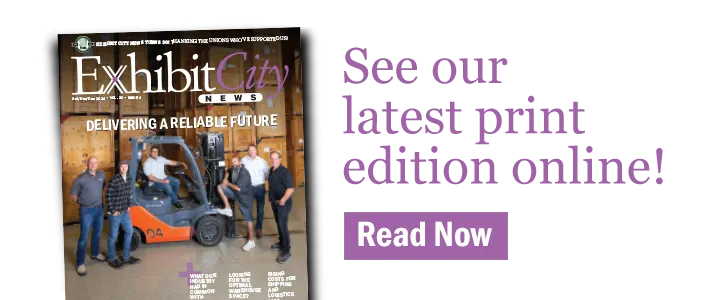As the new year approaches and the industry takes a deep breath before a busy January, Exhibit City News interviewed a number of tradeshow associations to find out about their 2011. In part one of this series, we talked with Steven Hacker, president of the International Association of Exhibitions and Events (IAEE) and Lew Shomer, executive director of the Society of Independent Show Organizers. Part two of this series will include the Healthcare Conventionand Exhibitors Association, the Exhibitor Appointed Contractor Association and the Exhibit Designers and Producers Association.

What is the most significant thing that happened to the tradeshow industry in 2011?
I don’t think you can identify a single most significant issue. The McCormick Place and MPEA reforms is one. I think that is important because it’s a signal that a recalibration will be considered in other jurisdictions. It will simply become a matter of competition and it will trickle down to the significant benefit of the customer.
The launching of brand USA, which resulted from the enactment of the Travel Promotion Act is also critically important to the industry because it will put the U.S. on the international travel promotion playing field for the first time.
The third thing was the launch of the industry-wide summit that resulted from the collaboration of the IAEE, ESCA and SISO because it lays the groundwork for real industry collaboration for the first time. I think the industry culture has to be repositioned so it consists of mutual support, quiet dialogue and the complete embargo on public headline grabbing that is aimed from one industry sector to another. It is destructive to the entire industry. We are all the same species, and we just can’t afford to eat our own young.
What was the most important thing that directly affected your membership?
That is the launch of our Click Here First public relations campaign. It is, we think, the most important project that has taken place in the 83 years of our organization. It is going to do outstanding things to promote the value of the face-to-face experience. I think it is long overdo.
What is the most noteworthy thing that your association accomplished throughout the year?
We radically reengineered our education and learning system internally at the IAEE. We now have a PhD candidate serving as our staff director of learning experiences. At the same time, we are linking that with a fairly comprehensive and terribly expensive job analysis project that is now analyzing every job in the exhibition industry. It goes from an entry-level position all the way to a CEO.
From your perspective, did the economy in 2011 improve significantly enough to directly impact the tradeshow industry?
For the last five quarters, the exhibition industry has consistently out performed the U.S. GDP, and in some cases it has doubled it. That is an indication that an industry rebound is well underway. To be able to outperform the GDP is pretty substantial. For all of those people outside of our industry who have offered opinions on the demise of the face-to-face experience, these metrics would seem to demolish their arguments.
Overall, how much more active was the tradeshow industry in 2011 versus 2010?
We are doing very well, and the activity has picked up substantially. And we are seeing that tradeshow activity has accelerated in the last three quarters especially.
What developments in 2011 have made you optimistic about 2012?
One of the key obstacles that we have been trying to manage has been the impact on the industry by federal agencies having to do with international travelers. We completely overreacted to the terrorist attacks of 9/11, and the pendulum swung entirely to the other end of the spectrum. It really choked the flow of international travel to the U.S. After 10 years, we are beginning to see a more logical system that allows international travel to the U.S.
The other issue is the revision of U.S. Visa Waiver program. Before 9/11, there were 19 countries whose citizens were exempt from having to get a visa to come here. We have now ratcheted that up to around 36.
What is the biggest challenge the industry will face in 2012?
I have no earthly idea and I say that seriously because I think the first casualty of this new century has been predictability. There surely is something ugly and challenging out there that none of us can anticipate. So a company needs to make itself more flexible and nimble than ever before and it needs to have crisis management programs in place.

What is the most significant thing that happened to the tradeshow industry in 2011?
Increased attendance and space sales – and I think one drives the other. In the latter part of 2010, we started to see an increase in attendance in the 2-5 percent range, although some shows went up to 20 – 30 percent. That, I think, was driving exhibitors to take more space, bringing in new exhibitors and resulting in old exhibitors coming back. Most economists predicted a very small percentage increase in the economy, and even the CEIR report is predicting 2-5 percent growth, but what we are actually seeing is that growth in revenues may be much larger.
What was the most important thing that happened that directly affected your membership?
When we came out of the recession, everyone talked about the new business model. And I think it made management take look at what they were doing versus what they needed to do to be more competitive and be more efficient. We found that in many instances, technology is driving people’s quest for information to the internet where previously they were depending on coming to the tradeshow. So the tradeshow has changed in terms of people’s expectations. They still enjoy the face-to-face experience, but the emphasis is no longer on the product, but the relationship between the buyer and the seller.
What is the most noteworthy thing that your association accomplished throughout the year?
The biggest thing that SISO has done is its amalgamation with other sister associations, including IAEE, UFI, ESCA, ABM and Amprofec. We have joint agreements with UFI and ABM and we have extremely close working relationships with IAEE and ESCA. We also have a marketing agreement with Amprofec.
Among this group, we have been able to work on all the issues facing the industry. SISO, ESCA and IAEE also put on an Association Coalition Summit. We invited 15 associations to one place to introduce one another and create an environment where we could exchange ideas personally as opposed to through the media.
From your perspective, did the economy in 2011 improve significantly enough to directly impact the tradeshow industry?
The economy grew, but it grew very insignificantly. Most of the economists are talking about 2-3 percent, but I think the impact on the tradeshow industry has been much greater. So I think we have been outpacing the economy. When I talk to my members, we are seeing that there has been significant increase in space sales and attendance throughout the year. And those numbers exceed what the economy is doing.
Overall, how much more active was the tradeshow industry in 2011 vs 2010?
It was much more active. From our point of view, we have seen several things that have changed dramatically. One is that mergers and acquisition are back, even though they were in smaller numbers than before the recession. Merger and acquisition activity is also coming back despite the fact that private equity sources are limited because government compliance with regards to borrowing is extremely difficult right now. That is a very good sign for our business.
What developments in 2011 have made you optimistic about 2012?
Again, if you see higher attendance, then you we are going to see more booth sales. It is as simple as that.
What is the biggest challenge the industry will face in 2012?
For the foreseeable future, it is technology because it is changing the way our business operates. And all these different technologies present different challenges. As for social media, we all talk about it all the time, but nobody can figure out how to make money off of it and nobody can figure out a way to use it consistently.































